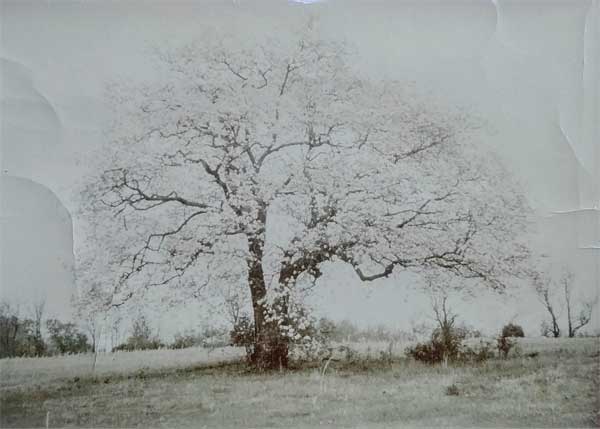The Largest Dogwood in the World!
Compiled by Lisa Orton
|
Community Radio show aired on KPSQ 97.3 FM: |
In his letter to the Editor of the Northwest Arkansas Times on May 2, 1955, Paul A. Marinoni wrote the following:
It was purely by accident, while fox hunting the other night, that I happened to see what I believe to be the largest dogwood tree growing in this region. Friends and I had climbed the hill behind my farm on Highway 16, West, to rest in a clearing so as to better hear the hounds, when the conversation drifted to large trees that we had seen. It was then that Jim Harrison asked how large a dogwood tree we had ever seen. I said the largest I had seen was about eight inches through. Ted McCawley, who is quite an experienced woodsman, went me better with a 12-inch diameter tree which he had seen. Jim Harrison then informed us that we were standing not over 50 feet from the largest dogwood he had ever seen. We all thought he was jesting since there was only one tree in the center of the field which had been cleared for many years. Jim took us over to the tree and I heard McCawley make the statement that HE had never seen a dogwood half as big as this tree. Coming from him, and seconded by the rest, I knew this must be a remarkable tree. And it is! I’ll tell you that this tree measures about six and one-half feet in circumference. It is owned by my good neighbors, the Markhams, and I think this tree deserves appreciative recognition, for I believe we have the 'GREATEST of them all', right here near Fayetteville!
Mrs. Joy Pratt Markham claimed her dogwood tree was the largest in the world.
From Ted Wylie’s feature entitled ‘Local Line’ in the April 14, 1962 issue of the Northwest Arkansas Times, he says,
Dogwood blooming time arrived in Northwest Arkansas these last few days, and the blossoms were never prettier. There are more pink and red blooms, judging from a drive around town. In the future when all the trees planted within the last little while come out Fayetteville is going to be even more beautiful. The largest dogwood tree, at Mrs. Markham’s, is ready for visitors who are invited to see it. Travel Markham road west past the home of Mrs. Joy Pratt Markham and through the gate into a field west of the house.
In the April 25, 1962 issue of the paper, in an article entitled ‘Adult Center Tea, Tour of City for Conventioneers’, it says that after the wives of members of the National Association of Retired Civil Service Employees had tea and a tour of the Community Adult Center, they visited points of interest in Fayetteville, including the University’s cut glass exhibit, and the dogwood tree now blooming at the home of Joy Pratt Markham.
In the April 4, 1967 issue of the paper, in an article entitled ‘Visitors Invited to See Largest Dogwood’, it says,
The largest dogwood tree in the world is at its blooming best this week, and the public is invited to see it. Located in a pasture west of the Markham home on the Pratt place west of the University Stadium, the tree, which grew up in an apple orchard, is 60 years old. Visitors who wish to see the tree may proceed west on Markham to the home of Joy Pratt Markham, park their cars and walk through a gate into the pasture where the tree stands by itself.
Ten years later, in a March 23, 1977 article entitled ‘Native Hardwoods Are A Majestic Resource’, David Zodrow writes,
The largest dogwood in Arkansas is located on Markham Hill in Fayetteville. The dogwood’s circumference is six feet, six and six-tenths inches and it is 23 feet tall with a spread of 29 feet.
In the March 18, 1979 issue of the paper, in an article entitled ‘4-H Seeks Champion Trees’, it says,
Washington County 4-H’ers are doing their part by helping Arkansas Forestry Commission workers locate possible champion trees here. The 4-H Arbor Day Committee met this week to re-dedicate the state’s champion dogwood tree, owned by (Mrs. Markham's sister) Evangeline Archer of Fayetteville and located atop Markham Hill.
According to Evangeline Archer’s son Julian (nephew of Mrs. Markham), this famous dogwood became diseased near the end of 1979 and died in the early 1980s after heroic attempts to try to rescue it. It is now totally gone.
